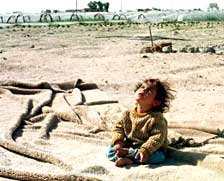|
Still, the shells of destroyed tanks |
  In front of a farmhouse near the Kuwait border,
Jabul passes time alone. In summer, the temperature
can rise to 50oC (121oF) where he is. (outskirts of Safan City) In front of a farmhouse near the Kuwait border,
Jabul passes time alone. In summer, the temperature
can rise to 50oC (121oF) where he is. (outskirts of Safan City) |
Using one of the days I stayed in Basra,
I headed for Safan, a town on the Kuwait
border. The area is controlled by the Iraqi
military. About 15 minutes drive from Basra,
we passed the checkpoint and entered the
zone monitored by a UN Peacekeeping Force.
Now and then a jeep or truck marked "UN"
passed by.
![]() Highway of Death
Highway of Death
"It's this whole area. During the Gulf War, our tanks, trucks, armored vehicles were destroyed all along here. Thousands were killed." My guide from Basra (48) was pointing out the window. At the time of the Gulf War (1991) he served on a video reporting team working for the Iraqi military.
The US and British soldiers called this the Highway of Death. This is where they toured the battlefield to "learn for the future." It is where they were exposed to radiation as they climbed up on tanks and other vehicles destroyed by depleted uranium (DU) weapons. As I was listened to my guide's explanation, I recalled the gruesome pictures I had seen while I was interviewing American Gulf War veterans.
The destroyed tanks and other debris near the highway have been all cleared away. In the distance, a powerful flame marked where natural gas was rising from the ground. Beyond that, more flames were licking up from the oil refinery. We drove for 45 minutes, about 65 kilometers (39 miles) south of Basra to Safan. The City Hall in this city of 28,000 was a stone's throw from the national border, which has been sealed off since the Gulf War.
In Iraq, media coverage procedures are required
and a new guide assigned every time the local
government changes. I suspect this serves
a "monitoring" function, but whenever
the person I interviewed was able to communicate
directly with me in English, the guide did
not stay with us. Literally, the guides were
coordinators, showing me around and helping
me to get exactly the information I wanted.
Their geographical knowledge of the area
often proved extremely helpful. However,
I arrived at the Safan Hospital with three
guides, the one from the Ministry in Baghdad,
the one from Basra, and the one assigned
in Safan.
![]() 250 to 300 people a day visit the hospital
250 to 300 people a day visit the hospital
The waiting room at the entrance was filled with old, young, male, and female. They were being seen by three doctors and one dentist. A female doctor, Suad Kasn (30), allowed me to interview her as she took a brief rest in a separate room.
"We see 250 to 300 patients a day. We see a lot of leukemia, lymphomas, and other cancers, but anyone we suspect of having cancer we send on to Basra to the hospital there. That's all we can do. We don't have the equipment for accurate diagnosis or proper treatment."
Respiratory and alimentary disorders, headache, joint pain and other disorders are remarkably numerous. Dr. Suad is especially worried about breast cancer. Of the approximately 6,000 women in Safan between 20 and 45, 20% complain of lumps in their breasts. We refer them for precise tests, and very frequently they come back having had surgery.
Congenital defects are also increasing. "In the Safan vicinity, there are still destroyed tanks lying around, and many areas shelled by DU munitions. Nearly all our residents breathed DU particles, and we are still experiencing the effects of environmental contamination." Dr. Suad insists.
![]() PKF moves to avoid danger
PKF moves to avoid danger
Several destroyed tanks lying about 25 kilometers (15 miles) south of Safan at the foot of Senamu Mountain (which means Camel Mountain). The building used for barracks by the PKF abandoned "because the PKF moved to a safer place." I dropped by a farmhouse nearby. I found an old carpet rolled out in the yard, and a little boy just sitting there.
"His name is Jabul. He's almost 8, but he isn't growing. He's got a congenital birth defect. He can't speak either." Bekya Suad (30) the boy's mother wearing a black hejab told me this as she gazed at her son. She was pregnant during the Gulf War. He is the second of seven children. "I'm worried because he eats almost nothing."
She says her tomatoes covered by vinyl are
doing well because they have plenty of water.
"Depleted uranium? Never heard of it,"
says Bekya. Tomatoes are grown all across
the wide fields behind Jabul. I can't help
wondering how safe they are.